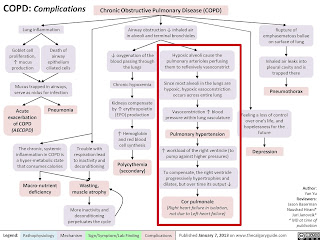BIMONTHLY INTERNAL ASSESSMENT - OCTOBER
CASE:1
57 year old man with jaundice, pedal edema and abdominal distension since three years and bleeding gums since three days"
- CHRONIC LIVER DISEASE (ALCOHOL INDUCED LIVER CIRRHOSIS)
- HYPOALBUMINEMIA
- TRUNCAL OBESITY >> METABOLIC SYNDROME >> NAFLD >> CIRRHOSIS
In hepatic encephalopathy (due to cirrhosis of liver ) damage occurs to brain cells due to the impaired metabolism of ammonia is predominantly related to the development of asterixis in hepatic encephalopathy,
pathophysiology of HE
1 role of neurotoxins,
2.impaired neurotransmission due to metabolic changes in liver failure, changes in brain energy metabolism, systemic inflammatory response and alterations of the blood brain barrier which produces a wide spectrum of nonspecific neurological and psychiatric manifestations.
https://www.ncbi.nlm.nih.gov/pmc/articles/PMC5421503/
Lactulose promotes increased uptake of ammonia by colonic bacteria which utilize the trapped colonic ammonia as a nitrogen source for protein synthesis. The reduction of intestinal pH facilitates this process, which favors the conversion of ammonia (NH3) produced by the gut bacteria, to ammonium (NH4+), an ionized form of the molecule, unable to cross biological membranes.
Lactulose also causes a reduction in intestinal production of ammonia. The acidic pH destroys urease-producing bacteria involved in the production of ammonia. The unabsorbed disaccharide also inhibits intestinal glutaminase activity, which blocks the intestinal uptake of glutamine, and its metabolism to ammonia.
Salt restriction <2.4gms/day to prevent retention of water due to osmotic gradient as sodium causes retention
3. Inj augmentin 1.2gm IV/BD to prevent secondary bacterial infections
4. Inj pan 40 mg IV/OD
5. Inj zofer 4mg IV/BD
6. Tab lasilactone (20/50)mg BD ( combination of furosemide and aldactone to decrease pedal oedema
If SBP <90mmhg - to avoid excessive loss of fluid
7. Inj vit k 10mg IM/ STAT ( as vitamin K causes coagulation to further prevent bleeding manifestions
8. Syp lactulose 15ml/PO/BD for hepatic encephalopathy
9. Tab udiliv 300mg/PO/BD contain ursodeoxycholic acid used to dissolve gallstones
10.syp hepameiz 15 ml/PO/OD - It is used for protecting the liver from harmful chemicals or free radicals. L-ornithine- L-aspartate (LOLA), the salt of the natural amino acids ornithine and aspartate acts through the mechanism of substrate activation to detoxify ammonia.
11.IVF 1 NS slowly at 30ml/hr to maintain hydration
12. Inj thiamine 100mg in 100mlNS /IV/TID as thiamine deficiency's occur in chronic alcoholics
13.strict BP/PR/TEMP/Spo2 CHARTING HOURLY
14.strict I/O charting
15.GRBS 6th hourly
16.protein x powder in glass of milk TID for protein supplementation and muscle wasting which commonly occurs in cirrhosis patients
17. 2FFP and 1PRBC transfusion to support coagulation pathways
CASE:2
A 54 year old male with cough,abdominal tightness,pedal edema and diarrhea.
https://sainiharika469.blogspot.com/2020/09/hello- everyone.html?m=1
- ALCOHOLIC CIRRHOSIS OF LIVER >> PORTAL HYPERTENSION
- LATE BUDD-CHIARI SYNDROME
- HYPOALBUMINEMIA
ORS sachets in 1 litre of water to compensate electrolytes lost due to diarrhoea
Inj PIPTAZ 4.5gm for antibiotic cover
Vit k 10 mg Iv OD for 5 days to prevent forthcoming bleeding manifestations as his PT INR APTT are elevated
IVF - 1 DNS @50ml/hr for hydration
Nebulisation with salbutamol and mucomist 12th hourly for cough and crepts
Inj thiamine 100 mg in 100 ml NS IV TID. for chronic alcoholism.
CASE:347 year old man with bipedal edema since one year and abdominal distension since one month
1) What will be your further approach toward managing this patient of nephrotic syndrome? How will you establish the cause for his nephrotic syndrome?
Further approach towards managing is:
ACE INHIBITORS and ARB'S : reduce intraglomerular pressure by inhibiting angiotensin II ̶ mediated efferent arteriolar vasoconstriction and thus have proteinuria-reducing effect.
Renoprotective effect of ACE INHIBITORS
- Reduced breakdown of bradykinin (an efferent arteriolar vasodilator)
- Restoration of size and charge selectivity to the GCW
- Reduced production of cytokines that promote glomerulosclerosis and fibrosis, such as transforming growth factor (TGF)–beta.
CALCIUM CHANNEL BLOCKERS
IMMUNOSUPPRESANTS
To establish the cause for his nephrotic syndrome:
Rule out the secondary causes:
Secondary causes of nephrotic syndrome
Other diseases
Diabetes mellitus
Systemic lupus erythematosus
Amyloidosis
Cancer
Myeloma and lymphoma
Drugs
Gold
Antimicrobial agents
Non-steroidal anti-inflammatory drugs
Penicillamine
Captopril
Tamoxifen
Lithium
Infections
HIV
Hepatitis B and C
Mycoplasma
Syphilis
Malaria
Schistosomiasis
Filariasis
Toxoplasmosis
Congenital causes
Alport’s syndrome
Congenital nephrotic syndrome of the Finnish type
Pierson’s syndrome
Nail-patella syndrome
Denys-Drash syndrome
AUTOIMMUNE SCREEN to rule out an underlying autoimmune disease is antinuclear antibody (ANA), antidouble stranded DNA antibody (dsDNA), and complement values (C3 and C4)
- Bleeding
- Infection
- Injury to other organs in the area
- Inadequate and/or no specimen for interpretation
- Blood loss sufficient to require either surgery or blood transfusion to stop the bleeding.


Comments
Post a Comment